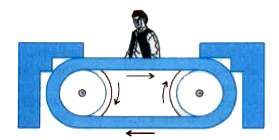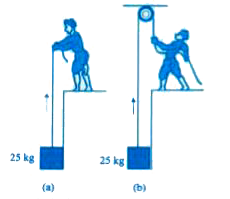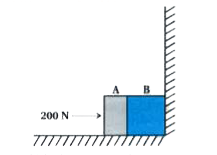Complete Solutions to SECTION -B (ADDITIONAL EXERCISE ) of chapter LAW OF MOTION of Class 11 book with complete answers and questions
| Class 11 | PHYSICS |
| Chapter | LAW OF MOTION |
| KUMAR PRAKASHAN | SECTION -B (ADDITIONAL EXERCISE ) |
| Number Of Questions | 17 |
| Academic Year | 2023-24 |
The position-time graph of a body of mass 0.04 kg. Suggest a suitable physical context for this motion. What is the time between two consecutive impulses received by the body? What is the magnitude of each impulse ?

View SolutionA man standing stationary with respect to a horizontal conveyor belt that is accelerating with 1 m s- 2 . What is the net force on the m an ? If the coefficient of static friction between the man’s shoes and the belt is 0.2 up to what acceleration o f the belt can the man continue to be stationary relative to the belt ? (Mass of the man = 65 kg).

View SolutionA stone of m ass m tied to the end of a string revolves in a vertical circle of radius R. The net force at the lowest and highest points of the circle d irected vertically dow nw ards are : [Choose the correct alternative]
Lowest Point (a) mg - `T_(1)`
(b) `mg + T_(1)`
(c) `mg + T_(1) - (mv_(1)^(2))//R`
(d) `mg - T_(1) - (mv_(1)^(2))//R` Highest Point `mg + T_(2)`
mg - `T_(2)`
`mg - T_(2) + (mv_(1)^(2))//R`
`mg + T_(2) + (mv_(1)^(2))/R`
`T_(1)` and denote the tension and speed at the lowest point. `T_(2)` and `v_(2)` denote corresponding values at the highest point.
View SolutionA helicopter of m ass 1000 kg rises with a vertical a c c ele ra tio n o f 15 `ms-^(2)` . The crew an d th e passengers weigh 300 kg. Give the magnitude and direction of the,
(a) Force on th e floor by th e crew and passengers.
(b) Action of the rotor of the helicopter on the surrounding air.
(c) Force on the helicopter due to the surrounding air.
View SolutionA stream of water flowing horizontally with a speed of 15 m s'1 gushes out of a tube of cross-sectional area 10-2 `m_(2)` and hits a vertical wall nearby. What is the force exerted on the wall by the impact of water assum ing it does not rebound ?
View SolutionTen one-rupee coins are put on top of each other on a table. Each coin has a mass m. Give the magnitude and direction of (a) the force on the 7th coin (counted from the bottom) due to all the coins on its top, (b) the force on the 7th coin by the eighth coin, (c) the reaction of the 6th coin on the 7th coin
View SolutionAn aircraft executes a horizontal loop at a speed of 720 km/h with its wings banked at `15^(@)`. What is the radius of the loop
View SolutionA train runs along an unbanked circular track of radius 30 m at a speed of 54 km/h. The mass of the train is `10^(6)` kg. What provides the centripetal force required for this purpose - The engine or the rails ? What is the angle of banking required to prevent wearing out of the rail ?
View SolutionA block of mass 25 kg is raised by a 50 kg man in two different ways as shown in figure. What is the action on the floor by the man in the two cases ? If the floor yields to a normal force of 700 N, which mode should the man adopt to lift the block without the floor yielding ?

View SolutionA monkey of mass 40 kg climbs on a rope as shown in figure which can stand a maximum tension of 600 N. In which of the following cases will the rope break the monkey.

(a) Climbs up with an acceleration of 6 `ms^(2)`.
(b)Climbs down with an acceleration of 4 `ms^(2)` .
(c )Climbs up with a uniform speed of 5 `ms^(1)` .
(d)Falls down the rope nearly freely under gravity ? (Ignore the mass of the rope).
View SolutionTwo bodies A and B of masses 5 kg and 10 kg in contact with each other rest on a table against a rigid wall as shown in figure. The coefficient of friction between the bodies and the table is 0.15. A force of 200 N is applied horizontally to A. What are (a) the reaction of the partition, (b) The action-reaction forces between A and B ? What happens when the wall is removed ? Does the answer to (b) change, when the bodies are in motion ? Ignore the difference between `p_(s)` and `p_(k)`.

View SolutionA block of mass 15 kg is placed on a long trolley. The coefficien t of static friction between the block and the trolley is 0.18. The trolley accelerates from rest with 0.5 `ms^(2)` for 20 s and then moves with uniform velocity. Discuss the motion of the block as viewed by (a) a stationary observer on the ground, (b) an observer moving with the trolley.
View SolutionThe rear side of a truck is open and a box of 40 kg mass is placed 5 m away from the open end as shown in figure. The coefficient of friction between the box and the surface below it is 0.15. On a straight road, the truck starts from rest and accelerates with 2 `ms^(2)` . At what distance from the starting point does the box fall off the truck ? (Ignore the size of the box)

View SolutionA disc revolves with a speed of 33 `1/3` rev/min. 3 and has radius of 15 cm. Two coins are placed at 4 cm and 14 cm away from the centre of the record. If the co-efficient of friction between the coins and the record is 0.15 which of the coins will revolve with the record ?
View SolutionYou may have seen in a circus a motorcyclist driving in vertical loops inside a ‘deathwell’ (a hollow spherical chamber with holes, so the spectators can watch from outside). Explain clearly why the motorcyclist does not drop down when he is at the uppermost point with no support from below. What is the minimum speed required at the uppermost position to perform a vertical loop if the radius of the chamber is 25 m
View SolutionA 70 kg man stands in contact against the inner wall of a hollow cylindrical drum of radius 3 m rotating about its vertical axis with 200 rev/min. The coefficient of friction between the wall and his clothing is 0.15. What is the minimum rotational speed of the cylinder to enable the man to remain stuck to the wall (without falling) when the floor is suddenly removed ?
View SolutionA circular coil of radius 8.0 cm and 20 turns is rotated about its vertical diameter with an angular speed of 50 rad `s^(-1)` in a uniform horizontal magnetic field of magnitude `3.0 xx 10^(-2)` T. Obtain the maximum and average emf induced in the coil. If the coil forms a closed loop of resistance 10`Omega`, calculate the maximum value of current in the coil. Calculate the average power loss due to Joule heating. Where does this power come from ?
View Solution
SECTION -B (ADDITIONAL EXERCISE ) questions and complete solutions for chapter LAW OF MOTION of KUMAR PRAKASHAN KENDRA PHYSICS (GUJRATI ENGLISH) of Class 11
All Exercises from KUMAR PRAKASHAN Class 11 PHYSICS LAW OF MOTION
- (QUESTION PAPER) SECTION-A
- (QUESTION PAPER) SECTION-B
- (QUESTION PAPER) SECTION-C
- (QUESTION PAPER) SECTION-D
- SECTION -B (ADDITIONAL EXERCISE )
- SECTION -B (NUMERICAL FROM DARPAN BASED ON TEXTBOOK)
- SECTION -B (NUMERICAL FROM TEXTUAL EXERCISE)
- SECTION -B (NUMERICAL FROM TEXTUAL ILLUSTRATION)
- SECTION -E(MULTIPLE CHOICE QUESTIONS) (MCQS)
- SECTION-A(QUESTION PAPER)
- SECTION-A(TRY YOURSELF)(VSQS)
- SECTION-C(OBJECTIVE QUESTIONS) (VSQS)
- SECTION-D(NCERT EXEMPLAR SOLUTIONS)
- SECTION-F (QUESTIONS FROM MODULE)